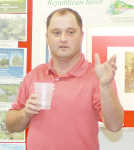Republican River group works toward cooperation

OBERLIN, Kansas -- At least two speakers at the January meeting of the Republican River Restoration Partners in Oberlin, Kansas, encouraged Kansas, Nebraska and Colorado to work together to solve challenges facing the Republican River.
Lorre McKeone, representing the Nebraska Water Balance Alliance, told the 40-or-so at the conference and meeting, "We can no longer afford to fight over water. We need to learn to work together."
Fred Raish, the director of the Yuma, Colorado, County Pest Control District, said, "It would be nice to see the three states work together. Nebraska and Colorado are working together. Hhmmm.... sorry, Kansas."

RRRP believes that the three states can work together to achieve long-term benefits and form partnerships to enhance water quality and quantity in the Republican river basin. The organization promotes conservation without compromising agricultural production and economic development.
The goal of the group is to provide leadership, planning and coordination of sound conservation practices and to bring federal, state and local entities together to implement a viable living Republican River Basin by 2037.
Speakers at the conference were Susan Stover of the Kansas Water Office, Tom Terryberry of the Nebraska Republican River Task Force, Lorre McKeone of the Nebraska Water Balance Alliance, Fred Raish of the Yuma County Pest Control District and Walt Geiger and Kyle Spencer of the Kansas Weather Modification Program.

Proposed legislation
Susan Stover of the Kansas Water Office in Topeka explained proposed legislation that would eliminate the "use it or lose it" concept in Kansas ground water law to encourage water conservation.
The development of proactive LEMAs (Local Enhancement Management Plans) would conserve water and lengthen the life of the Ogallala Aquifer, she said. LEMAs may include mandatory water use reductions, she said.

Legislation is also proposed to allow additional ground water "water banks" to relocate water use and to provide conservation in water-short areas.
Stover said that amendments in multi-year flex accounts would give irrigators expanded capabilities to manage their crop water over five years and allow users to match planning for water usage with long-term cropping and financing decisions.
Local control

Tom Terryberry of Imperial, Nebraska, a member of Gov. Dave Heineman's water task force, told those at the RRRP meeting that he supports local control of water supplies and water use.
Local governance is more acceptable to everyone, he said, especially when those making the rules must operate under the sale rules as everyone else.
Terryberry said that the task force is studying "conjunctive water management," the management of hydraulically-connected surface water and groundwater resources. Lorre McKeone of the Nebraska Water Balance Alliance, also a speaker at the RRRP meeting, described conjunctive management as "putting extra surface water into the ground (in times of surplus precipitation) and pumping it back out when it's needed (in times of drought)."
Terryberry said the Governor's task force is charged with making water supplies in the Republican River Basin sustainable and for using water efficiently now without creating economic hardships for future generations.
Water balance
Lorre McKeone of the Nebraska Water Balance Alliance explained that with each "watershed" moment in Nebraska's history -- droughts in the 1890s, 1930s, 1950s and early 2000s -- Nebraska capitalized on the opportunities to grow and prosper with the development of water rights legislation, surface reservoirs, ground water pumping and improved conservation and management practices.
What may be needed now, she said, is changes in the perception of how water is being used in the state. The historic perception is that irrigation is the biggest user of water, while a concept called the "Water Balance Approach" relies on the fact that evapo-transpiration consumes more than 90 percent of the total water supply.
The water balance approach counts precipitation and stream flow into the state as inputs in the water supply; and evaporation, natural vegetation, dryland agriculture, irrigation and stream flow out of the state as "deductions" from the supply. The difference between the two is the change in the water in storage. "We must understand total consumption," McKeone said.
Concerns over depletions in the Ogallala aquifer require new solutions, McKeone said, to ensure healthy, working streams and appropriate ground water levels.
Weather modification
Meteorologist Walt Geiger of the Kansas Weather Modification Program, Scott City, Kansas, said the goal of the program is to reduce hail and optimize rainfall over most of western and southwestern Kansas. For 37 years, the cloud-seeding program has been used as a water management tool for groundwater management districts in Scott City and Garden City.
Geiger said technology is catching up with the concept of rain augmentation and hail suppression, and there is increasing and renewed interest in weather modification.
The three state corners of Kansas, Nebraska and Colorado -- especially northeast Colorado -- are highly susceptible to hail, Geiger said.
The objectives of the program are:
* Seed clouds while crops are being planted, grown and harvested.
* Decrease the occurrence of crop-damaging hail by seeding thunderstorms.
* Optimize rainfall by seeding selected clouds in the absence of severe weather.
But the program still relies on nature, Geiger said. "If a cloud is only capable of a trace (of rain), why bother?" he asked. "If a cloud's capable of a toad-strangler -- three inches -- that's significantly different."
Vegetation control
Fred Raish, manager of the Yuma County Pest Control District, is attacking Russian olive and salt cedar on the Republican River in northeast Colorado.
Both trees were brought to the United States by U.S. governmental services, salt cedar for soil stabilization projects and Russian olive for windbreaks. They're not native and have very few natural enemies here, Raish said. And they're heavy drinkers, he said, sending tap roots deep toward water supplies, unlike native cottonwood and willow that slow down their water use in drought.
On the Republican, Raish's program also goes after overgrowths of native plants such as cattails that are choking channels of the river. On the Arikaree, the program is cleaning dead wood out of the creek, piling it into ricks on the banks and creating wildlife habitat.
In areas along the river where he's cleared overgrowths of Russian olive, Raish said, he's starting to see improved water flows. "I cannot prove how much we've changed (stream flows)," he said, but before and after photographs are showing improvements.
